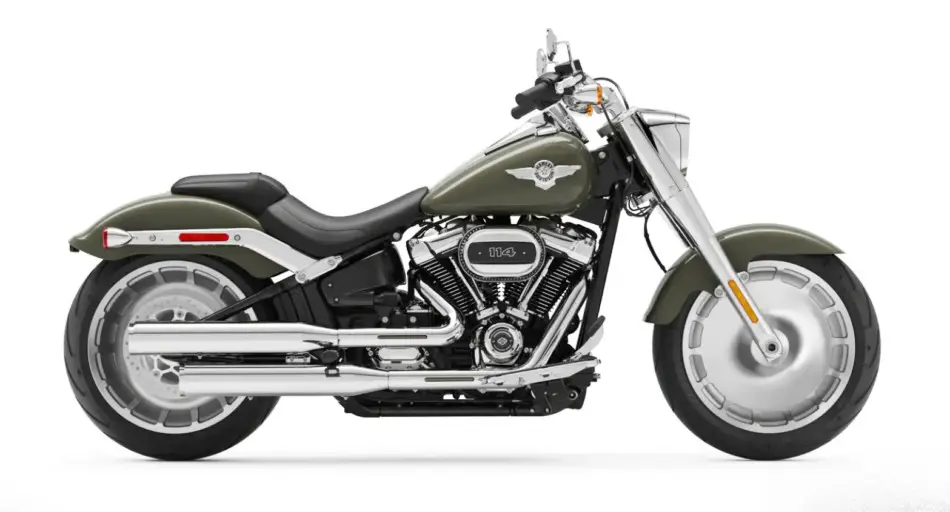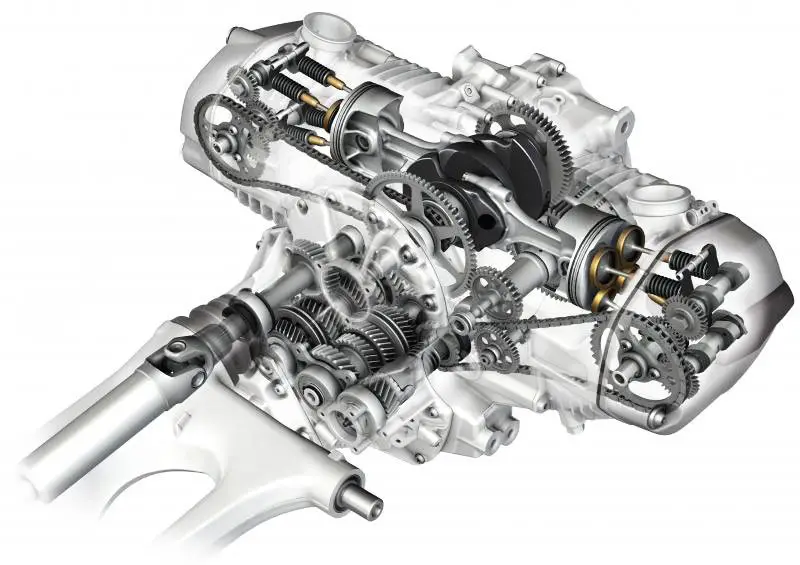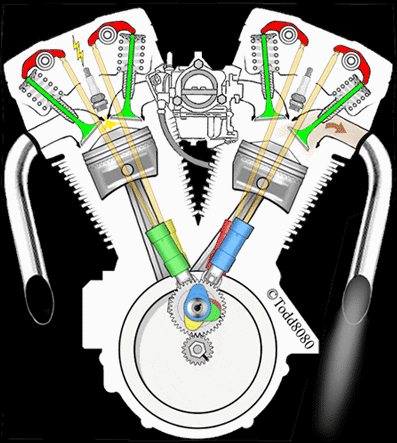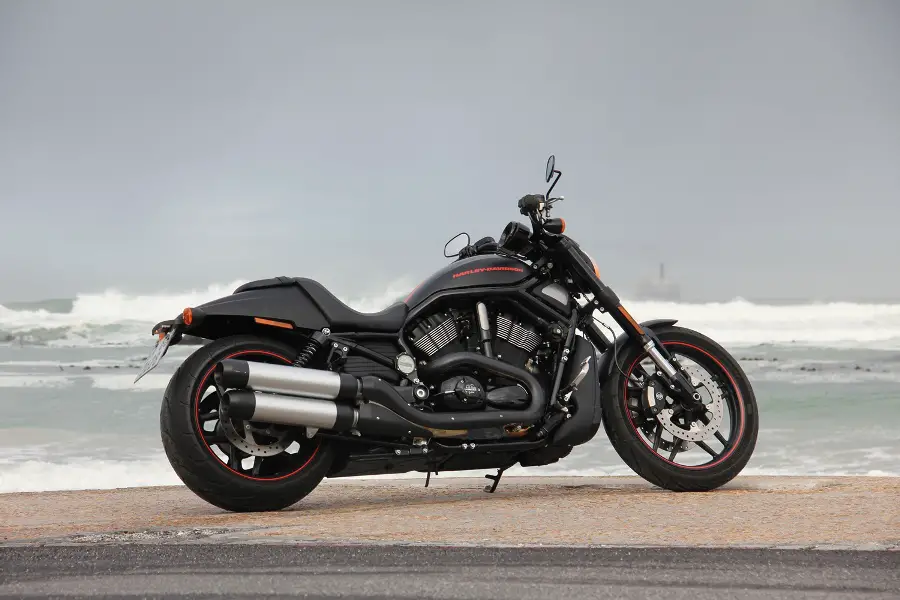Harleys do not only sound different from other bikes when they idle, it is almost as if they are misfiring. Harleys also shake more than your average Japanese motorcycle. What’s up with that?
Harley’s sound different from other motorcycles due to its 45 degree V-twin layout. With both pistons sharing one crankpin journal, the engine fires at 315 and 405 degrees resulting in a “pop pop pause” rhythm. The crank rotates slightly slower after the 405 degree rotation resulting in incomplete combustion on some rotations.
Let’s first look at why Harley sound so different at idle, before discussing the vibrations.
Why do Harleys Sound Different?
Harley Davidson motorcycles have two cylinders configured in a 45 degree V-twin layout. These air-cooled V-twin motors have become a styling design feature of Harley Davidsons and you won’t find a Harley without it. And it is also very visible. Harley doesn’t hide the engine from sight and has deliberately not evolved to liquid-cooled motors for that reason.

But 45 degree V-twins come with unique challenges.
Unlike most Japanese V-twins that sport separate crankpin journals (one for for each cylinder), Harleys have one crankpin journal that holds both piston connecting rods. This configuration means that both pistons in a Harley mostly move together as the one crankpin journal spins around the crankshaft.
On horizontally opposed twin engines, like BMW’s popular R 1250 GS, the two crankpin journals are 180 degrees apart. This means that one cylinder fires on one revolution, and the other on the next, exactly 180 degrees apart. That’s why BMW’s idle so smoothly and are so perfectly balanced.

Back to the uneven idling Harleys. Because of the engine layout (45 degree angle and single crankpin journal), Harley engines cannot be timed to fire exactly on each 360 degree rotation of the crankshaft.
Instead, after one piston fires the engine rotates 315 degrees (45 degrees short of 360) before the next one fires. Now the crankshaft has to rotate a full 405 degrees before the first cylinder fires again. That’s two whole rotations (315 + 405 = 720 degrees). This uneven firing results in that distinctive “Pop. Pop. pause. Pop. Pop. pause.” or as some riders refer to as “PoTaTo PoTaTo”.

Most other engines emit a perfectly timed “Pop Pop Pop Pop Pop Pop” idle due to the firing taking place at the same intervals of the rotation of the crankshaft.
Other twin-cylinder layouts
Honda employs a 270 degree parallel twin engine in the CRF 1100 L Africa Twin. Both pistons is oriented in the same direction, but fire 270 degrees apart for a more balanced engine. The KTM 1290 Super Adventure has a V-twin with both pistons mounted on a single crankpin (like Harley), but the pistons are 75 degrees apart, which diluted the ‘single-cylinder’ problem.
Other consequences of the Harley engine design is weight and cooling. To find out more about why Harleys are so heavy, read this detailed post I wrote. And if you are concerned about overheating in traffic, find out more on air-cooled motors in this post.
Why do Harleys Idle Rough?
A Harley’s uneven firing that results from the 45 degree layout on a single crankpin, means that the crankshaft will be spinning at different speeds at top dead center (TDC). The piston that fires after 405 degrees of rotation will spin slower than the one that fires after 315 degrees due to losing more momentum. Then, every time the piston fires the ignition timing is advanced, which slightly changes the ignition timing again.
At slow idle, combustion is not 100% complete on every stroke. That’s why you sometimes hear a proper ‘bang’ and other times a measly ‘pop’. At faster idle it all smooths out because of more consistent combustion.
The heavy flywheel on a Harley Davidson is supposed to offset the effect of the slowing crankshaft speed to some extent by maintaining the momentum, but this is more effective at higher engine speeds. Most Harleys should not idle lower than 850-900 RPM, otherwise the uneven-sounding effect becomes more pronounced.
Why to Harleys Shake so Much?
The uneven idling explained above will result in more vibrations, but there’s more to it than that.
Harley Davidsons shake when at idle due to the engine counter-weight swinging forward and backward in between up and down rotations. Harley’s 45 degree V-twin engine is counter-balanced with one big counter-weight to cancel out the momentum of the two pistons moving mostly together.
To counter balance an engine, a heavy weight (the counter weight) is swung in the opposite direction than the piston is moving in. In a parallel twin, this means the weight of the pistons and counter-weights are always evenly balanced (and cancelled out).
Because of the single crankpin which makes both pistons move together in the 45 degree V-twin configuration of the Harleys, you’ve got the same problem faced by single cylinder engines. As the two pistons swing up (mostly together), the counter-weight swings down. And when the pistons come back down, the counter-weight swings up again. This balances the engine, but only in one dimension (up and down).
Halfway in between strokes, the counterweight swings ‘forward’ and ‘back’, thereby unbalancing the engine in the for and aft dimension. In effect, the vibrations of the piston banging up and down is just transferred to front and rear. That’s why Harleys shake back or forth instead of up and down.
This shaking only takes place when standing still. As soon as you start moving, the forward momentum of the whole motorcycle completely dilutes the for and aft vibration resulting in a perfectly smooth ride.
This is a signature Harley trait: smooth engine while riding and rough when standing at the stop lights.
Conclusion
There you have it. The uneven idling and shaky vibrations of a Harley Davidson at idle is part of what makes it a Harley. It may have started out as a byproduct of a design that was aimed at a clean 45 degree V-twin look, but over time it became a signature Harley trait.
Imagine a smooth idling Harley that doesn’t shake… How weird would that be? Oh wait, one of my favorite Harleys of all time was the liquid-cooled, high-revving, V-Rod Night Rod Special. That one didn’t shake.

But true Harley fans hated it and so it didn’t survive.

